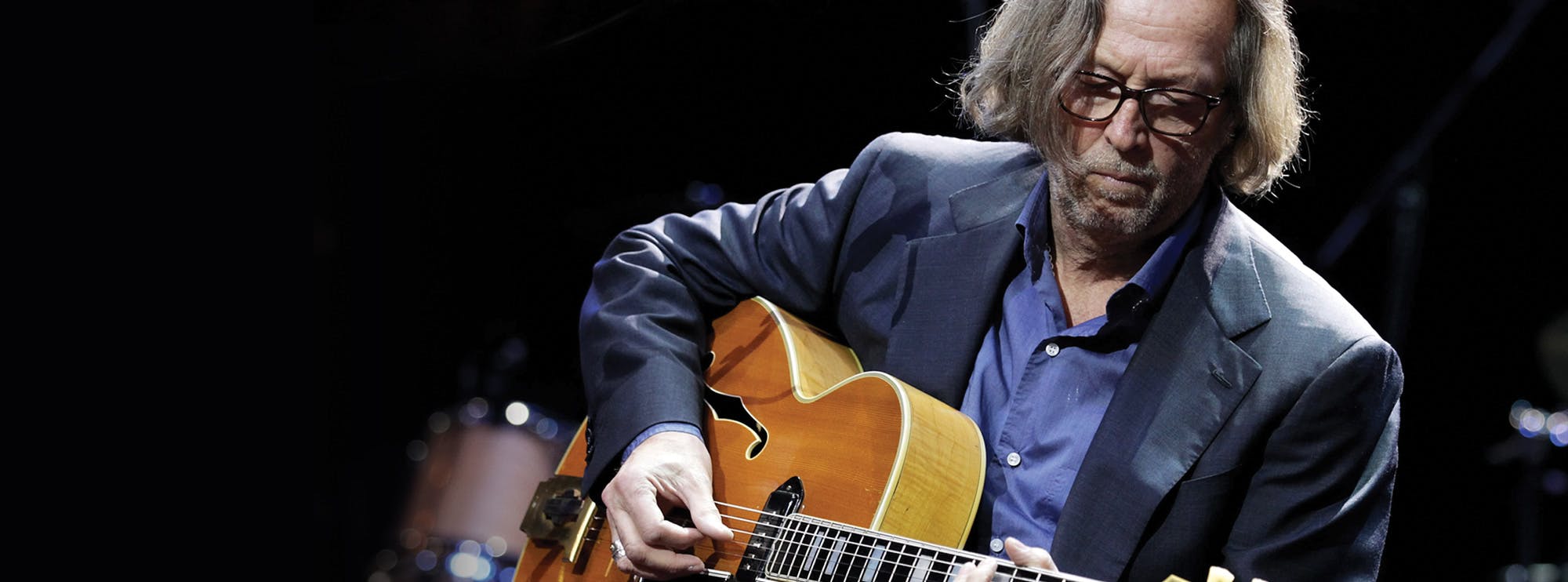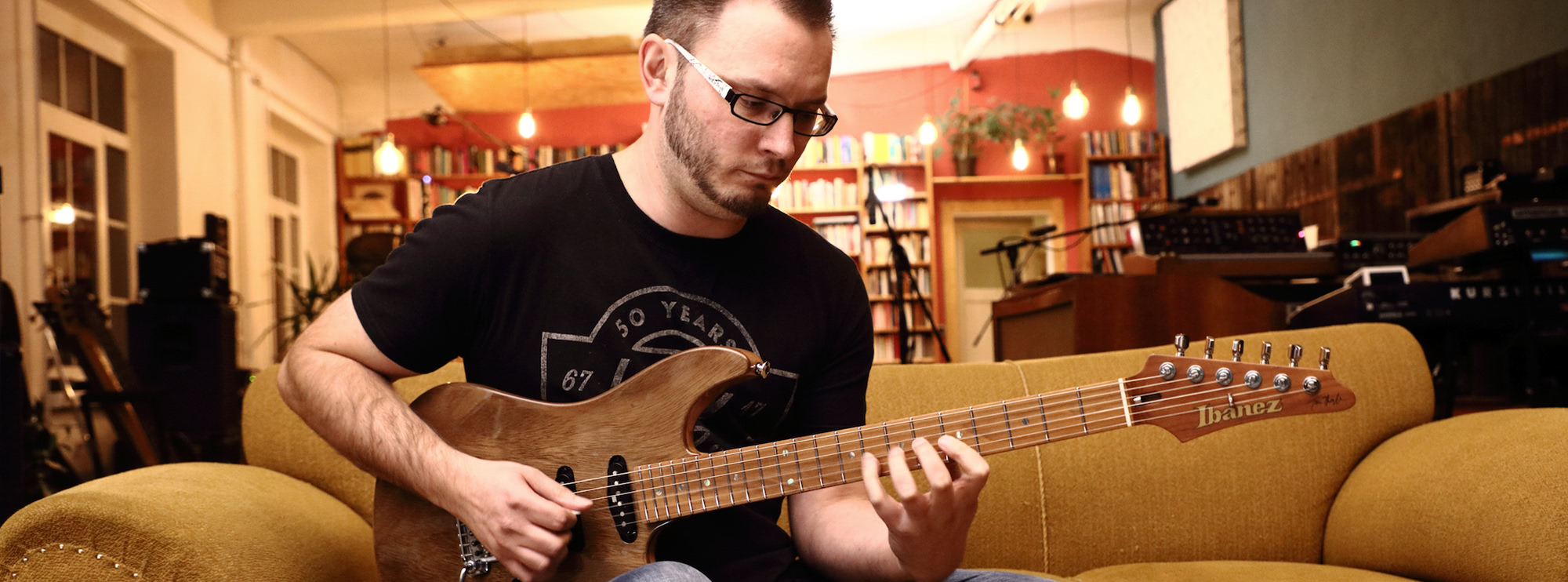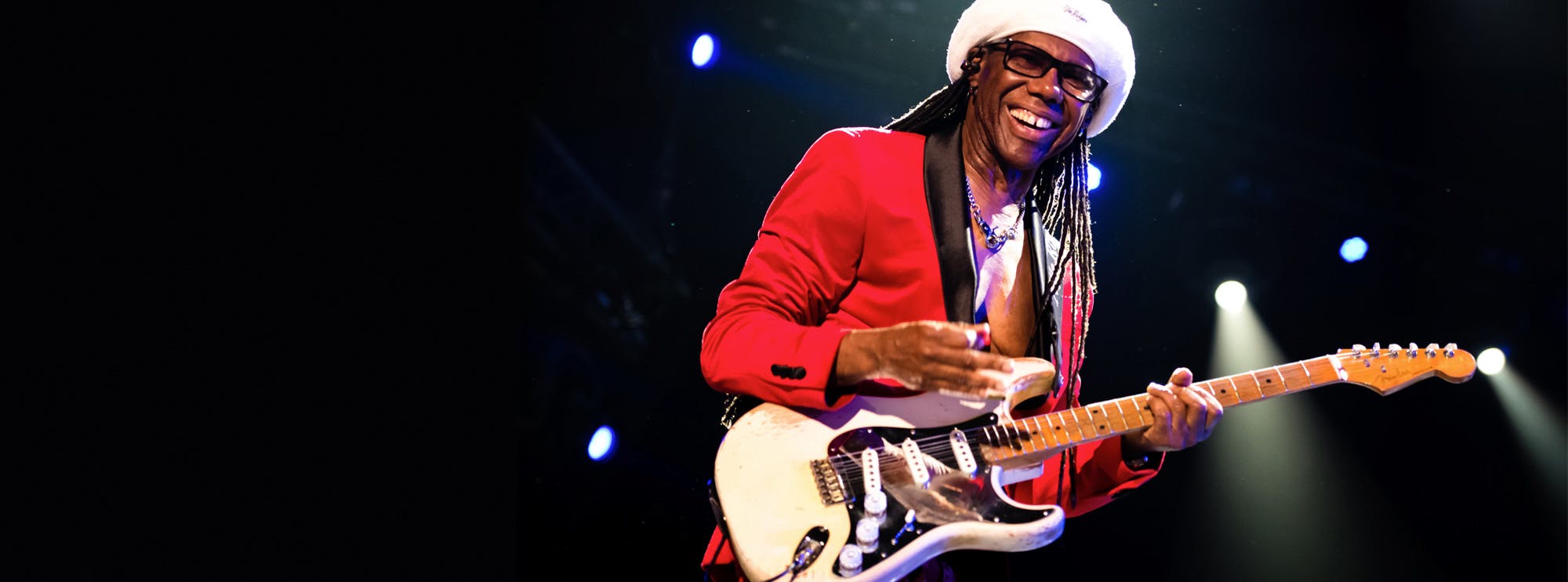Along with the likes of Jimmy Page, Eddie Van Halen, and Jimi Hendrix, Slash is one of the most influential and popular guitarists in Rock history. At a time when a lot of the bands from the LA scene wore more make up and hair products than girls, Slash and co. were a breath of fresh air, with their blend of sleazy Jack Daniels-fuelled hard Rock. Slash’s career has spanned more than 20 years, and he gained huge notoriety, as well as popularity, as the driving force duo with Axl Rose in Guns n’ Roses.
Many comparisons were drawn between the partnership of Slash and Axl, and that of Steve Tyler and Joe Perry from Aerosmith. But Slash also made a name for himself as a session guitarist, recording and working with such artists as Michael Jackson, Lenny Kravitz and even Carol King. Slash has also had various side projects including Slash’s Snakepit, Velvet Revolver and now, as a solo artist, performing with Alter Bridge vocalist Myles Kennedy. For our tech session I have chosen to focus on both the Guns n’ Roses and Velvet Revolver era.
Slash guitar tone on a budget:
Anxious to nail that Slash guitar tone but short of cash? Jamie Humphries shows you just how close you can get with a modest-priced rig!
Big sounds for small money - Gary Cooper explains the background.
Many classic albums have acquired volumes of folklore about how the particular guitar sound was produced - few more so than Guns ‘n’ Roses’ Appetite For Destruction, which has already been the subject of some analysis and speculation in this issue. In a perfect world, if your heart was set on replicating the sound, it would be simple. You’d jump in a conveniently placed time machine, go back a year or so and buy one of the, then new, limited edition Marshall AFD Slash heads (reviewed in this issue) get yourself a brand spanking new Gibson Slash Les Paul and, given you could manage the man’s technique, away you’d go!
Meanwhile, back on planet Earth, most of us don’t have that sort of money, so what hope is there for someone with more modest means?
We’ve put together a very affordable rig, which Jamie Humphries is using to show how close you can get without spending megabucks. I should add that we’ve decided to settle on the Peavey Vypyr 60 as our bedrock test amp for these ‘on a budget’ features. We initially reviewed the Peavey combo way back in the very first issue of iGuitar, when, on reflection, we were a bit less than generous with its star rating (the offending reviewer has, of course, been shot). Since then, the Vypyr has continued to grow on us and we now consider it to be a very fine all-purpose, all-rounder indeed - not least because of its extremely useful modelling facilities, which shone in issue 10’s Eddie Van Halen ‘budget’ feature. In fact we are so impressed with it as an ideal ‘gigging man’s amp’ - particularly for someone working in a covers band, as most semi-pros are at one time or another – that we’ve asked Peavey if we can hold onto it for a while longer as our benchmark test combo. Peavey has graciously said yes, so expect to see more of it over the coming months.
For a guitar in this test, we simply had no choice but to use the phenomenally good Vintage AFD Paradise that Jamie looks at in our review section. There are plenty of twin humbucker driven guitars on the market, many quite close in appearance to a real Gibson Les Paul - and some of them bearing Gibson’s sister brand’s Epiphone label. However, in a direct shoot-out last year between a Vintage and an Epiphone, we found we preferred the former, so it was to Vintage that we turned again for a review model this time around for our budget test. And if we thought we liked the previous Vintage...!
So, over to Jamie...
Slash’s Rig
Let’s start with guitars. Slash is probably one of the most famous Les Paul players in Rock. He has a huge collection of Les Pauls, but probably his best known and best loved is actually a 1959 replica, built by Kris Derrig. The guitar was bought for Slash by his manager for the recording of Appetite, due to the fact that Slash was struggling to get a good tone. The guitar came with Seymour Duncan Alnico II pickups and quickly became Slash’s main guitar. Another Les Paul that Slash is famous for using is his ‘87 Les Paul, bought just prior to the Appetite sessions. This guitar has been used on countless tours and recordings and is also loaded with Duncan Alnico Pro II pickups. There have also been various Gibson Les Paul Slash signature models, dating back as early as the late ‘80s, with a limited run of Slash models sporting black hardware. In 1997 Gibson released the “Snakepit” Les Paul, which featured Slash’s Snakepit graphic on the body, and a stunning snake motif on the fingerboard. Other popular models include the 2008 VOS Aged Les Paul, a perfect replica of Slash’s ‘87 Les Paul that came ready ‘aged’. The most recent addition to the long line is the stunning “Appetite” Les Paul, which is also available with an aged finish. Slash also tours with various prototype Appetite signature Les Pauls, all of which include the Duncan Alnico II slash Signature pickups, which we have tested elsewhere in this issue.
Amplifiers
Slash has always been associated with Marshall amps and has used various models over the years, including various signature models, including the original 90’s version with “Snakepit” logo, and the current Marshall “AFD” model, reviewed in this issue, which captures the perfect tone from the Appetite era. There is endless of speculation about the exact Marshall that was used for the Appetite session, but whatever it was, it is seen as producing his classic tone and Slash himself has tried to reproduce that tone with his current signature head.
Most probably, the amp in question was a modified Marshall 100 Watt 1959 Super Tremolo, owned by S.I.R, a rental company in LA, and it was known as “Stock #39”. The amp had previously been rented by George Lynch for the Under Lock and Key album, and had been modded by Tim Caswell, who basically used the amp’s unused tremolo circuit, with its additional pre-amp valve, to produce more gain. Also added to the amp was a master volume control.
Effects
Slash isn’t renowned for using too many effects, although he does have his own signature Dunlop Crybaby wah, and an octave fuzz pedal. He also uses delay, which splits his live rig in stereo. Slash also uses and MXR EQ pedal to boost his mids and also various other modulations, including tremolo and phaser.
The Budget Rig
To get our version of Slash’s sound I used the Vintage AFD Paradise guitar and a Marshall style amp model on the Peavey Vypyr 60 for both the clean and dirty tones.
I based the clean tones on Knocking on Heaven’s Door, and Fall to Pieces. The clean should be rich and full, using the neck pickup on the guitar, with the volume backed off slightly. Also try adding some chorus, as well as some subtle delay. I also used some digital reverb, which should be dialled in to taste and choice.
For the crunch tone I used the same Marshall style model, but set to crunch, with the addition of a boost to add more saturation and also exaggerate the upper mids and presence of the tone. Don’t use too much gain, but remember it is a hard rock tone.
Also make sure you boost the mids and try to keep the low end rich and full. For effects I used more delay and reverb. I dialled in a little extra delay for ambience. Be sure to study the accompanying video, and also check out my suggested tracks that I used to base the tones on. I think we got pretty close. You could do much the same with many twin humbucker equipped guitars and a few tube amps (Marshalls being the obvious choice) - but not a lot closer than we got on this sort of budget.
Good Luck! Before we kick into our track, it’s worth mentioning that Slash tunes his guitars to Eb, but to keep things a little more simple for those of you that have floating bridges, and also so that tuning is consistent in the magazine, I’ve presented this track in standard tuning. This track should also be performed with drop D tuning, with the low E string, the 6th string, being lowered by a whole tone.
Opening section:
The track kicks off with an intro section that features the chords of Dsus2, and Dsus2/#4 performed as chord arpeggios against the tom fill intro. The verse kicks in and features a driving power chord riff that is performed on the bottom 3 strings. This riff is based on a similar riff heard in the track Slither. Due to the drop tuning it’s possible to perform the riff with just one finger. The verse concludes with a descending figure on the D string that follows the riff.
Verse:
Now we have our main verse progression, which uses the same power chords found in the previous section, but this time we perform it with a tight palm muting. Pay attention to the video lesson and be sure to remove the palm mutes at specific points to make the riff more aggressive.
Chorus:
Now we have our chorus progression, with this being based around a similar progression to Fall to Pieces, and with the main guitar performing one of Slash’s signatures melody lines that outlines the chords. Make sure you back off the tone control to produce a smooth creamy tone for the lead melody. The chord progression is as follows: D5, Csus2, G/B, A5, G5, Bb5, and C5.
Middle eight section:
Now it’s time for our middle eight section which is based on the clean chords G, C, Am and D. This section should be performed in the same style as the verse chords to Knocking on Heaven’s Door and the intro to Fall to Pieces. This section is performed with clean chord arpeggios, a rich clean tone and a subtle chorus effect. The second half of the middle eight includes some high register triad chords that are performed on the top three strings. These triads follow the verse progression, and are based to the high register triads heard in the verses of Sweet Child O’ Mine. This middle eight is followed by a short intro section.
Guitar solo:
We conclude our track with a solo that uses notes from the D minor pentatonic and D blues scale. The D minor pentatonic is embellished with the addition of the E note, the 2nd of E. The solo includes many Slash style licks, including ascending pentatonic phrases, and fast repetition and bending licks. There are also some pre bends included, so make sure you pay attention to the pitch of the bends.
There are plenty of cool riffs and Slash inspired ideas for you to try in this Tech Session. Be sure to watch the accompanying video so that you nail the correct tone.
Good luck!
About The Tutor
Tutor Profile
Jamie Humphries
Jamie is one of the mainstays of LickLibrary, having a stream of hugely successful best selling DVDs, Jamie is best known as Brian May's sideman who he's played shows with all over the world. Aside from this Jamie is a hugely popular clinician working all over the world with Ernie...



